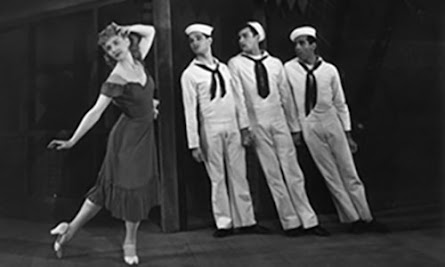Carry On... #Madison Avenue-wise
In December 1944, the musical On The Town opened on Broadway with a book by Betty Comden & Adolph Green, music by Leonard Bernstein and choreography by Jerome Robbins.
It told the story of three sailors with 24 hours shore leave in New York City, and it has gone on to become one of the iconic Broadway musicals of the era.
Although it was filmed in 1949 (with Gene Kelly, Frank Sinatra and Jules Munshin playing the three sailors) the film version makes a number of radical changes to the original Broadway work, most notably by removing almost all of Leonard Bernstein's music.
The film also takes place after the war has ended, which arguably alters the tone of the entire work. In the Broadway version, the three sailors have one day to enjoy their shore leave, after which they will be returned to active service, and almost certainly sent into combat. The girls they encounter are aware of this (and are aware that 24 hours is all they will ever have together). The audience too were acutely aware of this wartime precariousness when the show was running on Broadway. When the three sailors return to their ship at the end of the musical, they are heading into a very cloudy future, and it gave a certain urgency to the whole story that was missing from the peace-time film adaptation.
Anyway, that was On the Town, which I am not showing this week. Stay with me; this will make sense.
Son of On The Town Rides Again
Ten years later, writing duo Comden and Green (who had also starred in the original Broadway production, by the way) considered re-visiting those three sailors to explore what might have happened to them in the years after the war.
The "direct sequel" idea never actually happened (there were probably too many differences between the Broadway version and the film version for a sequel to make any sense) but It's Always Fair Weather stands as a spiritual (if not literal) successor to On the Town.
The three friends have new names, and are now soldiers rather than sailors, but in many other respects this could easily be On The Town Part II. One of them is even Gene Kelly.
But a lot can change in ten years, and the world of It's Always Fair Weather in 1955 was very different from the world of On The Town in 1945.
Rather than shy away from this, It's Always Fair Weather tackles it head on, exploring not only how these three friends might feel about each other if they were to meet up after ten years, but also exploring what has happened to society itself in those ten years.
The result is what has sometimes been described as a very rare "cynical musical" (rare, at least, among the MGM musicals of that period).
It's Always Fair Weather was also one of the first MGM musicals to be filmed in CinemaScope and it makes the most of the new wide-screen process while also laughing at the trending obsession with all things panoramic.
The cinema buzz-word of the early 1950s had been Cinerama; a very complicated, very expensive wide-screen process that used three cameras (and three projectors) to create an impossibly large, all-enveloping image (with very obvious joins between the three panels).
It's Always Fair Weather repeatedly divides the screen into three panels in gentle mockery of the Cinerama process, while also deftly visualising the gulf between the three friends as they grow apart over the years.
At one point the screen is again divided into three for a split-screen dance routine that remains a miracle of choreographic precision.
It's Always Fair Weather may not be the most famous of MGM's musicals, but it might just be the most topical. It certainly has a lot to say about where 1950s America was heading, and what that looked like to the people who were living through it.

















Comments
Post a Comment